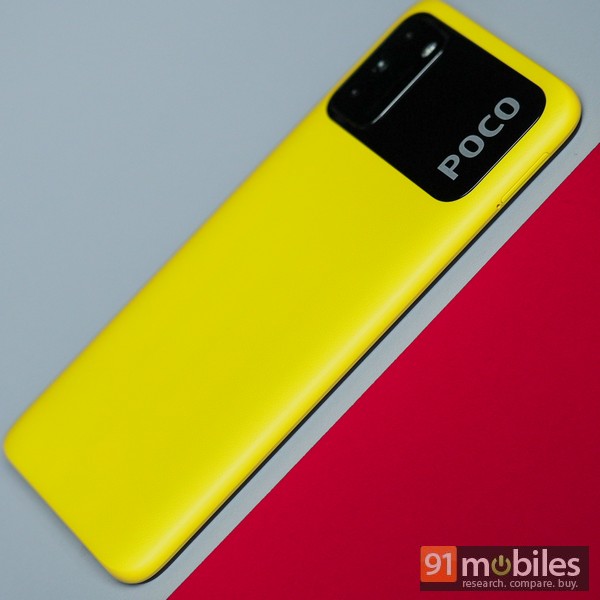Review Summary
Expert Rating
Xiaomi’s former sub-brand POCO has been diversifying its portfolio as of late. Since its split from Xiaomi, the company has been trying to solidify its position in the most important price segments of the Indian smartphone market. As such, the M series from POCO deals with the budget audience, and its last smartphone that came in the form of the POCO M2 was a big hit. Just a week back, after its launch in September 2020, the device surpassed 1 million sales, which is an impressive feat for any smartphone. Therefore, it was natural for the company to launch a successor to gain more traction in the lucrative sub-Rs 15,000 smartphone segment. Enter, the POCO M3, a phone that has been launched for a starting price of Rs 10,999. At this price, the M3 has stiff competition from the likes of Redmi 9 Power (review), Realme Narzo 20 (review), and the Moto G9 Power (review). So in this review, let’s see how the new POCO M3, with its unique design, stands up to its rivals.

Verdict
The M3 has done justice to the POCO brand name. The handset ships with a huge 6,000mAh battery and supports 18W fast charging too. What’s more, the design of the handset is extremely unique to the segment and it is undoubtedly going to grab eyeballs whenever you pull it out in public. The company could have utilised a more powerful chipset and offered better optics, but the POCO M3 is still tops my recommendation list in the budget segment.

Design and display
- Display: 6.53-inch IPS LCD
- Resolution: FHD+ (2,240 × 1,080)
- Refresh rate: 60Hz
- Protection: Gorilla Glass 3 front
- SIM: Dual nano
- Connectivity: USB Type-C

I don’t think it’s a stretch to call the POCO M3 one of the best-looking phones in its segment. Quite frankly I haven’t seen this kind of design on premium phones, let alone budget devices. The handset comes in three varied colour options, including yellow, Cool Blue, and black with a giant, glossy cutout surrounding the camera housing present on the back. The rest of the rear panel bears a textured finish which provides a very nice in-hand feel. A big advantage of the leather-like plastic back is that it won’t pick up any fingerprints and isn’t at risk of shattering should you accidentally drop it either. As for the rest of the design elements, a triple-camera set up along with the LED flash unit sits flush within the glossy cutout. Towards the bottom, the smartphone offers a USB-C port, a 3.5mm headphone jack and a speaker grille. Quite surprisingly, the smartphone’s earpiece doubles up as a secondary speaker to provides stereo sound, something that’s a rarity in this price range. The power button, which has been positioned towards the side, also integrates the fingerprint sensor, while just above it is a tactile volume rocker. As for ergonomics, the POCO M3’s 197g chassis makes it quite manageable to use day in and day out. Given how the phone packs in a massive 6,000mAh cell, the smartphone’s chassis is exceptionally lightweight, to say the least.

On the front, you will find a 6.53-inch display with FHD+ (2,340 x 1,080) resolution, with the selfie shooter housed inside a waterdrop notch. As can be expected from a budget smartphone, there are sizeable bezels around the screen but the panel itself has Corning Gorilla Glass 3 protection. The IPS LCD display on the M3 is much better than I had initially hoped for. Although the colours are a tad on the saturated side, that can easily be changed by selecting the standard Colour scheme option in the Display settings. As for the viewing angles, they are passable for an LCD panel, but the phone only comes with a 60Hz screen. I should also tell you that the phone features WideVine L1 certification which will allow you to stream content in HD on OTT platforms. Lastly, in terms of brightness, the POCO M3 offers a maximum brightness of 400 nits and correspondingly, I didn’t face any visibility problems indoors. That said, there were a few issues using the phone outdoors, in sunny conditions.

Cameras
- Rear cameras: 48MP main, 2MP wide-angle, and 2MP macro
- Front camera: 8MP
- Video shooting: 1080p @30fps, 720 @ 30/120fps

In terms of optics, the POCO M3 ships with a 48MP primary sensor that is accompanied by a 2MP macro shooter and a 2MP depth sensor. I was reasonably happy with the M3’s performance in daylight but not so much at night. Selfies from the 8MP camera were nothing to write home about either as the skin tones were slightly off and the facial details looked oversharpened. Let me sum up my experience with the smartphone’s optics briefly –

- In daylight, the sensor gets in quite a lot of details with some amount of smoothening. The focus usually remains quite sharp at the centre but around the edges, it is soft. Dynamic range and exposure calibration are decent but getting details out of a bright spot can be tough. Colours look slightly saturated, keeping the AI mode turned on helps. Shutter speeds are fast but sometimes the phone takes painfully long to focus on a subject.
- At night, shots are noisy and details are lacking despite the added assistance offered by nearby street lighting. Not to mention, AI Scene detection tends to overexpose the shots and outputs a blurry image lest you hold the smartphone extremely still. Thankfully, the dedicated Night Mode helps a lot in this regard, and with the feature enabled, you will be able to see a lot more information being squeezed from the shadows and the highlights. The exposure is controlled to some degree too but noise is still present in the images.
- The depth sensor works well to separate the background from the subject. Edge detection can be a problem in tricky conditions. Macro capabilities are limited given the low-resolution sensor but you do get a decent amount of details. However, a lot depends on the lighting surrounding the subject.
- Selfies are generally good but even without any face smoothening filters, the shots lack facial details. Front portrait shots did work well but not so much if the lighting dips.
- In terms of video recording, the rear camera can shoot a maximum of 1080p videos at 30fps. There is also the option for slow-mo recording at 720p @ 120fps.
Performance and software
- Chipset: Snapdragon 662
- RAM: 6GB
- Storage: 64GB, 128GB, expandable up to 512GB
- Software: MIUI 12 with Android 10 and POCO Launcher

Powering the POCO M3 is Qualcomm’s Snapdragon 662 chipset which is based on an 11nm manufacturing process. It isn’t the fastest chip in the market and features an octa-core Kryo 260 CPU setup that has a maximum frequency of 2GHz. To give you a better picture, in Geekbench 5, the POCO M3 logged scores of 312 and 1,381 for single-core and multi-core tests respectively. GFXBench’s Manhattan and T-Rex benchmarks for GPU performance returned 17fps and 31fps while Antutu’s overall score for the device was 178,246 points. Don’t get me wrong – the POCO M3’s performance is on par with the competition, the likes of which include Realme’s Narzo 20, etc. What’s more, benchmarks aside, I didn’t find any glaring issues with POCO M3’s day-to-day usage. I did run into some lags and stutters whilst navigating through the phone’s UI, but for the most part, the device works well. Furthermore, multitasking and switching between heavy apps was a lag-free affair too, although that can be accredited to my review unit’s 6GB of RAM. Quite interestingly, POCO offers 6GB of RAM on both storage variants of the M3 and neither the Narzo 20 nor the Redmi 9 Prime ship with as much RAM on their base variants. The starting price of Rs 10,999 will give you 64GB of storage while adding an extra Rs 1,000 will enable you to buy the 128GB model. A point to note here is that the 64GB version has UFS 2.1 storage while the 128GB variant has the faster UFS 2.2.

The POCO M3’s gaming performance is nothing to write home about, which is expected given the chipset. In Call of Duty Mobile, you can push the Graphics Quality to Very High and Frame rate option to High but the phone starts exhibiting frame drops after a 30-minute gaming session. Correspondingly, if you have intentions of playing heavy games on your phone, then perhaps the POCO M3 is not the best of choices. The phone has a side-mounted capacitive fingerprint sensor which works quite well. A special mention also to the excellent stereo speaker setup which is loud, crisp, has great depth and doesn’t crackle at max volume. You have dual-SIM 4G capabilities on the device and I had tested the phone on Jio’s Noida network to find no signal drop.

On the software side of things, the POCO M3 runs Xiaomi’s MIUI 12 skin which has been optimised for POCO devices. One of the biggest advantages is that you are not going to see ads pre-baked into the skin like other Xiaomi phones. There is also an app drawer present on the custom POCO launcher, which is missing on Xiaomi devices. However, the bloatware problem still persists, with several duplicate apps making their way into the UI… and they can’t be uninstalled either. The drop-down quick settings have big, bold icons while the main settings menu is more refined now. You can read more about the UI in my POCO C3 review.

Battery
- Battery: 6,000mAh
- Charging speeds: 18W fast charging
- 0-50 percent: 50 minutes
The massive 6,000mAh battery is one of the phone’s biggest highlights and it’s impressive how light the M3 feels in my hand despite that. Even with a good, full-day usage which involved a lot of video streaming, the phone managed to retain 45 percent of its battery by the time I hit the bed. You can easily push it to be a two-day workhorse provided you aren’t gaming on the phone. On top of that, POCO also provides an 18W charger inside the box. While the beefy size of the battery will take some time to charge, the extended power backup more than makes up for it. During my testing, the phone took around 2 hours and 20 minutes to charge completely. Apart from that, PCMark’s standard Battery 2.0 test yielded an impressive time of 20hr 44min, which is among the best we’ve seen on a smartphone in this price bracket. I firmly believe that POCO’s battery management and relatively faster charging speeds play a big role in putting the phone above its competition.

Final Verdict
POCO seems to have a come a long way since becoming independent and it’s clear why. It can be considered an enthusiast brand, much like OnePlus in its early years. The company has released some compelling products in the mid-range and budget segments, such as the POCO X3 and the POCO M2 Pro. Both devices have a focus on specs and features that would appeal to smartphone aficionados. It looks to me that POCO has tried to do the same with the M3, but choosing a different direction. The company has made a super flashy phone with a giant battery which set it apart. The display, camera quality, software and performance are about as good as they can get on budget phones too. POCO’s inclusion of 6GB RAM in all its variants is definitely a bonus. All-in-all, there are other good phones in the market for budget audiences and the POCO M3 is right above there at the top with Xiaomi and Realme.

Editor’s rating: 4 / 5
Pros
- One-of-a-kind design
- Excellent battery life
- Capable stereo speakers
Cons
- Cameras could have been better
- Gaming performance isn’t a strong suit
 | Rs. 8,990.00 | Go To Store |




































